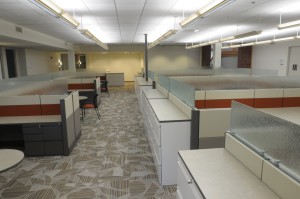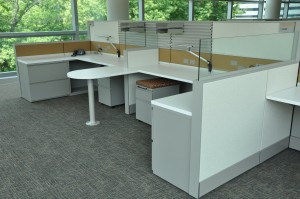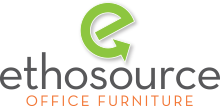 One side says cubicles are out of date and old fashioned, while the other says that open floor plans are distracting and unproductive. So what’s the right answer? Well, it may not be as simple as that. Your office design should be as unique as your business, and that means considering the specific needs of your employees and the company’s goals and philosophy. There are, however, a few tips to prevent your office design from hurting productivity and teamwork. By incorporating these various elements into your workplace, you can encourage certain behaviors and work styles that will benefit everyone involved.
One side says cubicles are out of date and old fashioned, while the other says that open floor plans are distracting and unproductive. So what’s the right answer? Well, it may not be as simple as that. Your office design should be as unique as your business, and that means considering the specific needs of your employees and the company’s goals and philosophy. There are, however, a few tips to prevent your office design from hurting productivity and teamwork. By incorporating these various elements into your workplace, you can encourage certain behaviors and work styles that will benefit everyone involved.
Forget Uniformity: Yes, it’s true that the days of endless cubicle rows are over, but the days of cubicles in the workplace are far from it. They’ve been developing along with the current office trends to incorporate new ways of working. Not every employee is the same, so they can’t all find the same happiness and productivity in the exact same workspace. The collaborative, open space that works for one employee may not suite the needs of someone requiring more privacy from noise and distractions.
The beauty of cubicle systems such as that of Herman Miller Ethospace is that even cubicles that have joint walls can have completely different styles and functions. Incorporate acoustic tiles to minimize sound for those who need more privacy or add glass/open tiles to higher walls to create a more open feel. Keep in mind the abilities of cubicles to create very unique layouts from one station to the next, so that everyone can feel comfortable in the space they work.
Think In Clusters: Workstations allow individuals to have a space to call their own, but they can also foster creativity and collaboration. The organization of desks can eliminate the feel of an assembly line and create a hub for communication. In addition to separate meeting rooms, you can encourage communication by grouping together workstations within an open space, so employees can face one another.
By using glass or low dividers, employees can feel they have their own space while enabling them to be more attentive of when coworkers are available or interacting with others, which will aid the flow of ideas in the midst of routine conversations.
 Consider Every Space a Workspace: The best ideas no longer come from behind a desk. or even in a conference room. While those areas may still be necessary, you shouldn’t rule out any room in the office as a place for employees to connect and engage one another. A kitchen as simply a kitchen is valuable wasted space. Adding tables or chairs will create a cafe feel that will invite employees to linger and communicate with one another during random parts of the day.
Consider Every Space a Workspace: The best ideas no longer come from behind a desk. or even in a conference room. While those areas may still be necessary, you shouldn’t rule out any room in the office as a place for employees to connect and engage one another. A kitchen as simply a kitchen is valuable wasted space. Adding tables or chairs will create a cafe feel that will invite employees to linger and communicate with one another during random parts of the day.
The same goes for hallways, print and copy rooms, etc. Add benches to these areas and a place to plug in electronics and phones. Don’t rule out any space as a hang out area. Even in passing, ideas can spark. Tom Polucci, director of interior design for HOK, a global design and architecture firm, says that the best ideas come from unexpected places. “Studies show people are actually more productive and innovative when in motion. New office designs encourage that by swapping dingy concrete service stairwells for ornate, centralized open stairwells, and installing signage that encourages people to use the stairs instead of the elevator.”
Natural Light: Take advantage of the beauty and energy efficiency of natural lighting. It’s an opportunity to be creative! It’s proven to make employees feel happier and more productive throughout the work day, especially those whose jobs have them behind a desk most of the day. Our internal clocks control when we are tired or awake, and this can actually be regulated by sunlight exposure. Keep workstations close to windows and focus on ventilation with open tiles and glass walls. Outdoor break areas are also a good way for employees to get the most from the benefits of natural light.
Color: Bright colors can be a great way to enhance the mood of the workplace and give your office an impressive, modern look, but certain colors and patterns can also be harmful to work ethic. Avoid stripes and plaids. Although they may seem cool, they’re distracting and can even cause headaches. Stay away from colors that are too bold, like red, yellow and purple. These colors may be stimulating, but they’re also overpowering. Even bright white can cause strain on the eyes and brain.
Stick to primary colors that are light and easy on the eyes. Examples such as light blue, orange, gold, and soft yellow provide a cheerful and positive environment without overwhelming the room.
Sources: Your Office Design is Killing Teamwork
Workplace Decorating Color Tips for Walls to Avoid the Stripes Effect
